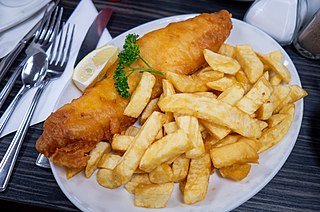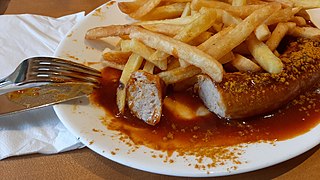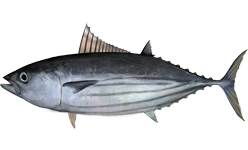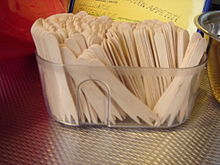
French fries, chips, finger chips, french-fried potatoes, or simply fries, are batonnet or julienne-cut deep-fried potatoes of disputed origin from Belgium or France. They are prepared by cutting potatoes into even strips, drying them, and frying them, usually in a deep fryer. Pre-cut, blanched, and frozen russet potatoes are widely used, and sometimes baked in a regular or convection oven; air fryers are small convection ovens marketed for frying potatoes.

The cuisine of Germany consists of many different local or regional cuisines, reflecting the country's federal history. Germany itself is part of the larger cultural region of Central Europe, sharing many culinary traditions with neighbouring countries such as Poland and the Czech Republic. In Northern Europe, in Denmark more specifically, the traditional Danish cuisine had also been influenced by German cuisine in the past, hence several dishes being common between the two countries.

A potato chip or crisp is a thin slice of potato that has been deep fried, baked, or air fried until crunchy. They are commonly served as a snack, side dish, or appetizer. The basic chips are cooked and salted; additional varieties are manufactured using various flavorings and ingredients including herbs, spices, cheeses, other natural flavors, artificial flavors, and additives.

Fish and chips is a hot dish consisting of fried fish in batter, served with chips. The dish originated in England, where these two components had been introduced from separate immigrant cultures; it is not known who combined them. Often considered Britain's national dish, fish and chips is a common takeaway food in numerous other countries, particularly English-speaking and Commonwealth nations.

In cutlery or kitchenware, a fork is a utensil, now usually made of metal, whose long handle terminates in a head that branches into several narrow and often slightly curved tines with which one can spear foods either to hold them to cut with a knife or to lift them to the mouth.

Deep frying is a cooking method in which food is submerged in hot fat, traditionally lard but today most commonly oil, as opposed to the shallow frying used in conventional frying done in a frying pan. Normally, a deep fryer or chip pan is used for this; industrially, a pressure fryer or vacuum fryer may be used. Deep frying may also be performed using oil that is heated in a pot. Deep frying is classified as a hot-fat cooking method. Typically, deep frying foods cook quickly since oil has a high rate of heat conduction and all sides of the food are cooked simultaneously.

A fast-food restaurant, also known as a quick-service restaurant (QSR) within the industry, is a specific type of restaurant that serves fast-food cuisine and has minimal table service. The food served in fast-food restaurants is typically part of a "meat-sweet diet", offered from a limited menu, cooked in bulk in advance and kept hot, finished and packaged to order, and usually available for take away, though seating may be provided. Fast-food restaurants are typically part of a restaurant chain or franchise operation that provides standardized ingredients and/or partially prepared foods and supplies to each restaurant through controlled supply channels. The term "fast food" was recognized in a dictionary by Merriam–Webster in 1951.

Take-out or takeout is a prepared meal or other food items, purchased at a restaurant or fast food outlet with the intent to eat elsewhere. A concept found in many ancient cultures, take-out food is common worldwide, with a number of different cuisines and dishes on offer.

Fast food is a type of mass-produced food designed for commercial resale, with a strong priority placed on speed of service. Fast food is a commercial term, limited to food sold in a restaurant or store with frozen, preheated or precooked ingredients and served in packaging for take-out or takeaway. Fast food was created as a commercial strategy to accommodate large numbers of busy commuters, travelers and wage workers. In 2018, the fast-food industry was worth an estimated $570 billion globally.

Rémoulade is a cold sauce. Although similar to tartar sauce, it is often more yellowish, sometimes flavored with curry, and often contains chopped pickles or piccalilli. It can also contain horseradish, paprika, anchovies, capers and a host of other items.

Currywurst is a fast food dish of German origin consisting of sausage with curry ketchup. It was invented in 1949 by Herta Heuwer, who began selling it at a food stand in Berlin. The Deutsches Currywurst Museum estimated that 800 million currywursts are eaten every year in Germany, with 70 million in Berlin alone.

The foodservice or catering industry includes the businesses, institutions, and companies which prepare meals outside the home. It includes restaurants, grocery stores, school and hospital cafeterias, catering operations, and many other formats.

Architectural Digest is an American monthly magazine founded in 1920. Its principal subjects are interior design and landscaping, rather than pure external architecture. The magazine is published by Condé Nast, which also publishes international editions of Architectural Digest in China, France, Germany, India, Italy, Mexico/Latin America, the Middle East, Poland, and Spain.

The skipjack tuna is a perciform fish in the tuna family, Scombridae, and is the only member of the genus Katsuwonus. It is also known as katsuo, arctic bonito, mushmouth, oceanic bonito, striped tuna or victor fish. It grows up to 1 m (3 ft) in length. It is a cosmopolitan pelagic fish found in tropical and warm-temperate waters. It is a very important species for fisheries. It is also the namesake of the USS Skipjack.

Birds Eye is an international brand of frozen foods founded in the United States and now owned by Conagra Brands in the United States, by Nomad Foods in Europe, and Simplot in Australia.

Epicurious is an American digital brand that focuses on food and cooking-related topics. Created by Condé Nast in 1995, it is headquartered at the One World Trade Center in Manhattan, New York City, where it is part of the publisher's Food Innovation Group that also includes Bon Appétit, with significant overlap in staff between the two companies.

A Gatsby is a South African submarine sandwich consisting of a bread roll filled with chips and a choice of fillings and sauces. It originated in Cape Town and is popular throughout the Western Cape province. The sandwich is typically large and shared by several people.

Vegetarian Cooking for Everyone is a 1997 cook book by Deborah Madison. It contains 1,400 vegetarian recipes from soups to desserts.

Volkswagen currywurst is a brand of sausage made by the German car manufacturer Volkswagen since 1973 at the Wolfsburg Volkswagen Plant — and sold in restaurants in its six German factories as well as in supermarkets and at football stadiums — and given to Volkswagen customers. The sausage is branded as a Volkswagen Originalteil "Volkswagen Original Part" under part number 199 398 500 A.

Cuisine of Berlin describes different aspects of Berlin's culinary offerings. On the one hand, it means the traditional Berlin cuisine of Berlin households with dishes from the German cuisine. On the other hand, often a rustic pub and snack kitchen, which has become increasingly international due to many migration waves since 1945 and 1990. After 2000, numerous top-class restaurants have evolved in Berlin.




















